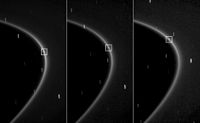|
Aegaeon (moon)
Aegaeon /iːˈdʒiːɒn/, or Saturn LIII (provisional designation S/2008 S 1), is a natural satellite of Saturn. It has an extremely elongated shape whose surface is thought to be similarly smooth as Methone.[6] It orbits between Janus and Mimas within Saturn's G Ring. Discovery and namingImages of Aegaeon were taken by Cassini on 15 August 2008, and its discovery was announced on 3 March 2009 by Carolyn Porco of the Cassini Imaging Science Team using the provisional designation S/2008 S 1.[4] Aegaeon was named after one of the hekatonkheires on 5 May 2009.[7] Orbit2008 Cassini images of the bright G Ring arc with Aegaeon embedded within it. These images were taken over the course of ten minutes. Aegaeon orbits within the bright segment of Saturn's G Ring, and is probably a major source of the ring.[8] Debris knocked off Aegaeon forms a bright arc near the inner edge, which in turn spreads to form the rest of the ring. Aegaeon orbits in a 7:6 corotation eccentricity resonance with Mimas,[3] which causes an approximately 4-year oscillation of about 4 km in its semi-major axis, and a corresponding oscillation of a few degrees in its mean longitude. It orbits Saturn at an average distance of 167,500 km in 0.80812 days, at an inclination of 0.001° to Saturn's equator, with an eccentricity of 0.0002.[4] Physical characteristicsAegaeon is the smallest known moon of Saturn outside of the rings and has an extremely elongated shape, measuring 1.4 km × 0.5 km × 0.4 km (0.87 mi × 0.31 mi × 0.25 mi) in size.[9] Measurements of its mass show that Aegaeon has a very low density, likely due to a highly porous and icy interior structure.[5] Aegaeon has the lowest albedo, below 0.15, of any Saturnian moon inward of Titan.[10] This might be due to either darker meteoric material making up the dust in the G ring or due to Aegaeon having been disrupted, stripping away its ice-rich surface and leaving the rocky inner core behind.[10] ExplorationThe Cassini spacecraft has performed four flybys of Aegaeon closer than 20,000 km, though only one has occurred since its discovery in 2008. The closest of these pre-discovery encounters took place on 5 September 2005 at a distance of 8,517 km.[11] An encounter on 27 January 2010 at a distance 13,306 km allowed Cassini to acquire its highest resolution images of Aegaeon.[10] On 19 December 2015, Cassini was unable to capture any images from a planned close flyby. NotesReferences
|
||||||||||||||||||||||||||||||||||||||||||||||||||||||||||


